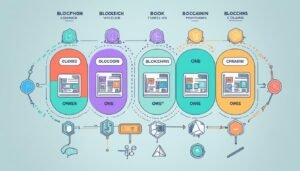The blockchain world is changing fast, ready for big growth and new ideas. Experts predict the global blockchain market will jump from $27.84 billion in 2024 to a huge $825.93 billion by 2032. This shows how much people are getting into decentralized tech across different areas. Blockchain is becoming key in digital changes and the growth of cryptocurrencies.
DeFi, short for Decentralized Finance, is changing how we think about money. By the end of 2021, DeFi had almost $250 billion invested, showing its big potential. Countries like El Salvador and the Central African Republic are using Bitcoin to help their economies grow and make sending money easier.
Also, companies in new markets are using blockchain for better payments across borders. Web3 is starting a new internet era focused on being decentralized and using tokens. Big names like Meta and Microsoft are putting a lot into the Metaverse, showing blockchain’s wide impact in creating new digital worlds.
Key Takeaways
- The global blockchain market is set to grow exponentially, from $27.84 billion in 2024 to $825.93 billion by 2032.
- DeFi represents a significant shift from traditional financial systems to decentralized, peer-to-peer financial models.
- Countries like El Salvador and the Central African Republic are paving the way for Bitcoin adoption to boost economic growth.
- Integration of blockchain with Web3 and the Metaverse is driving the next generation of internet experiences.
- Blockchain technology is increasingly adopted for cross-border payments, enhancing transparency and efficiency.
Revolutionizing Blockchain Innovation: AI’s Impact and Future Trends
Artificial intelligence and blockchain are changing the tech world together. They make things more secure, clear, and work better. AI quickly analyzes lots of data, which helps blockchain’s security and trust. This mix makes AI apps safer and helps blockchain grow, making transactions clear and trustworthy.

Companies use AI and blockchain to understand big data securely. This is key as the AI and blockchain market could hit $703 million by 2025. Working together, these technologies are growing fast, with a 25.3% annual growth rate from 2020 to 2025.
The following table shows how AI and blockchain work together:
| Benefit | Impact |
|---|---|
| Enhanced Data Management | Optimizes processes and improves accuracy |
| Better Transaction Efficiency | Reduces costs by addressing redundant tasks |
| Improved Security Measures | Augments protection against fraud |
| Increased Scalability | Facilitates handling a larger volume of transactions |
| Boosted Transparency | Provides clear, traceable transactions |
AI is getting better in areas like robotics and understanding language. Blockchain is also growing, touching on things like DeFi and Web3 apps. Projects like Bittensor and Ocean Protocol are leading the way in new tech.
AI and blockchain are changing many fields, like finance and healthcare. For example, IBM and Maersk use blockchain for supply chains. CoreLedger is working on secure health record software.
Breaking the Mold: Top Trends in Blockchain Scalability Solutions
The blockchain world is growing fast, and making it work better for more people is key. Big networks like Ethereum, Solana, and Avalanche are leading the way. They’re always getting better to handle more transactions and grow.
Then there are Layer 2 solutions, like Polygon and the Lightning Network. These help networks do more without losing their core values of being secure and fair. For example, Polygon has handled over a billion transactions, showing how well these solutions work.
As we keep improving, we aim to make a system that can support more uses. By working on both Layer 1 and Layer 2, we keep blockchain efficient and ready for many applications.

| Feature | Layer 1 Networks | Layer 2 Solutions |
|---|---|---|
| Examples | Ethereum, Solana, Avalanche | Polygon, Lightning Network |
| Primary Focus | Security, Decentralization, Protocol Integrity | Scalability, Transaction Throughput |
| Transaction Speed | Varies (relatively slower) | Significantly faster |
| Use Cases | Core Network Transactions, Smart Contracts | Microtransactions, Off-Chain Processing |
Finding the right mix between Layers 1 and 2 is key for blockchain’s future. As we move forward, these new solutions will set the bar for how scalable and fast blockchain can be.
IoT’s Influence on Future Blockchain Development: A How-To Guide
The mix of blockchain and IoT could change many areas like supply chains, smart cities, and energy use. This combo makes sure transactions are secure and efficient in IoT systems.
Putting blockchain and IoT together solves big problems. It makes apps that are open, clear, and traceable. For example, in supply chains, it helps track products well, cuts down on fraud, and builds trust with consumers. Also, the secure data ecosystems from blockchain help keep health info safe, leading to better diagnoses and treatments.
In the energy field, blockchain IoT is a game-changer. It makes energy use more efficient, cuts costs, and lets people trade energy directly. This leads to a new kind of energy market. Blockchain’s strong encryption and spread-out system keep data safe from hackers.
- Transparency: Blockchain IoT builds trust by keeping a permanent record of deals.
- Efficiency: It makes things run smoother and cuts out the middlemen.
- Scalability Solutions: It tackles big challenges with sharding and off-chain deals, handling more IoT devices.
The future looks bright for blockchain and IoT together. We’ll see more use in logistics, farming, making things, and more. AI and ML will help make smart choices in these apps, pushing Industry 4.0 and Society 5.0 further.
With emerging technologies in blockchain leading the way, we’re looking at big economic gains in new markets. It will boost farming, health care, and financial access, helping the economy grow in a green way.
Sustainable Blockchain Innovations: Navigating the Future with Eco-Friendly Solutions
The blockchain industry is growing fast, making eco-friendly solutions a must. Now, new blockchain apps are being made to lessen harm to the environment.
Proof-of-Stake (PoS) is a big change in the blockchain world. It’s better than the old Proof-of-Work (PoW) because it uses less energy. Ethereum 2.0 is leading the way with this change, making things more sustainable and scalable.
Some blockchain projects are even working on carbon offsetting. This means they try to balance out their carbon emissions. These efforts help make the crypto world cleaner and friendlier to the planet.
Green crypto projects also aim to be more scalable. They use less energy to work, which means faster and safer transactions.
More people want to invest in projects that are good for the planet. This interest in green crypto is pushing the blockchain industry to be more eco-friendly.
| Green Crypto Project Attributes | Details |
|---|---|
| Consensus Mechanism | Proof-of-Stake (PoS) |
| Energy Efficiency | Higher than Proof-of-Work (PoW) |
| Carbon Offsetting | Actively Participating |
| Scalability | Improved Transaction Speed and Efficiency |
| Investment Demand | Growing Interest in Sustainability |
My NEO Group is a top name in this field. They mix advanced crypto payments with green practices. NEO Zentech teams up with ZENIQ to improve their blockchain tech, leading in fintech.
My NEO Group follows strict rules in many countries. This shows their dedication to being sustainable in today’s tech world.
Decentralized Finance (DeFi) Revolution: Future Impact on Blockchain
Decentralized finance, or DeFi, is changing the way we think about money. It moves from old, centralized systems to new, peer-to-peer ones. This change is thanks to blockchain technology, which makes financial services available everywhere, all the time.
DeFi is growing fast, with things like lending platforms and stablecoins becoming more popular. In 2020, the DeFi market was worth $13 billion. By 2027, it’s expected to be over $200 billion. This growth is thanks to smart contracts, which make financial deals automatic and cut out the middlemen.
Blockchain helps make transactions clear and safe, cutting down on fraud. It also lets users control their money and keep it safe from hackers. This means more people can use financial services like loans and savings, even if they weren’t able to before.
China’s Digital Yuan project is a great example of how blockchain can change finance. Since starting, it’s handled over $13.68 billion in transactions. This shows how blockchain could change finance all over the world.
DeFi offers many benefits, like better security and access to money. As more countries plan to introduce their own digital currencies, DeFi is set to become a key part of finance.
For those interested in DeFi, learning about its principles and uses is important. For more information, check out Investopedia.
In summary, DeFi’s peer-to-peer finance fits well with blockchain’s goals. It also promises a future where more people can access and use financial services.
Quantum Computing and Blockchain: A Glimpse into the Future Technology
The mix of quantum computing and future blockchain technology is changing the game in digital innovation. Quantum computing is getting faster, making it possible to solve complex problems that were too hard before. This is great news for blockchain, as it means better encryption and stronger disruptive blockchain applications.
Now, blockchain uses old encryption methods that might not work well with new quantum algorithms. Quantum computers could break into data that was once safe. So, we need new encryption methods to keep blockchain safe from cyber threats.
Quantum computing and blockchain could also change how we do things like cryptocurrency mining. With quantum, some tasks that take years could be done in seconds. This could make mining faster and greener, which is good for the planet.
Also, combining quantum computing with future blockchain technology will change how we manage supply chains. Quantum can analyze data better, cutting down on waste and improving delivery routes. Blockchain makes sure everything is clear and trustworthy, making supply chains better for everyone.
| Technology | Application | Potential Impact |
|---|---|---|
| Quantum Computing | Cryptography | Unbreakable encryption |
| Future Blockchain Technology | Supply Chain | Enhanced efficiency and transparency |
| Technological Convergence | Cryptocurrency Mining | Increased efficiency and sustainability |
| Disruptive Blockchain Applications | Financial Modeling | Smarter investment strategies |
In summary, combining quantum computing with blockchain is a big deal. It means we’ll have super powerful computers and super secure data. As we look for ways to do things better and greener, this tech combo is key. It’s a big step forward for digital fields and keeps us safe from cyber threats.
Evolutionary Governance Models in Blockchain Innovation: Future Perspectives
The blockchain world is always changing, making it key to understand and use good blockchain governance models. These models help with making decisions in a fair way. They are important for managing blockchain projects well.
Looking ahead, we need to focus on new ways to govern blockchains. This will help make the blockchain world better and more open.
A study found that looking at the good and bad of permissioned blockchains helps with keeping big ICT systems safe. Also, tests showed that the hyperledger fabric identity authentication (HIDA) works well in cloud computing. These results are important for improving blockchain governance.
Looking at 75 articles on blockchain topics like NFT and P2E shows us new business ideas and uses. Also, 50 recent studies on Mobile Ad Hoc Networks show how blockchain can be flexible and efficient.
Using smart contracts, blockchain, and zero-knowledge-proof tech can make car insurance better. Looking at how Ethereum is developed gives us new ideas for better governance in smart contracts.
Good governance can help many areas, like voting systems and car-hailing online. For example, some voting systems need to be easier to use, but blockchain could be a solution.
| Field | Governance Model | Key Benefits |
|---|---|---|
| Online Car-Hailing | Policy Formulation, Experimental Regulation | Decentralized, Transparent, Tamper-Proof |
| Smart Contracts | Ethereum Development Strategies | Secure, Efficient |
| Cloud Computing | HIDA Protocol | Identity Authentication, Enhanced Security |
Fusion of Blockchain and Emerging Technologies: 5G, AR/VR Integration Guide
Blockchain is teaming up with 5G and AR/VR to change the digital world fast. This mix uses blockchain’s secure, decentralized ways to boost many areas. It opens up new chances for making things better and more efficient.
Blockchain and 5G together could change a lot of things. 5G’s fast speed makes blockchain work better, making sure data moves quickly and safely. This is great for things like money transfers, tracking goods, and checking identities, making them faster and more reliable.
AR/VR and blockchain mix to create safe, real virtual worlds. This is big news for gaming, the metaverse, and learning. Blockchain keeps virtual items real and secure, while AR/VR makes the experience exciting and real. Together, they make digital interactions safe and fun.
Blockchain is getting better, bringing new ideas to many fields. Things like predicting when machines need fixing, managing energy smartly, and watching over things from far away are getting better. These solutions make things safer, clearer, and cheaper, changing how companies handle data.
By using 5G, AR/VR, and blockchain, companies can find new ways to work better and make more money. It’s key for businesses to get these new blockchain solutions to stay ahead in our connected world.
Securing the Future: Blockchain Innovations and Addressing Security Challenges
The world of blockchain security is getting more complex and exciting as it grows. We need better cryptographic advancements and new blockchain solutions for the future. With over 54 million active addresses using blockchain, keeping the network safe is crucial.
There are different ways to secure blockchain networks, like Proof of Work (PoW) and Proof of Stake (PoS). These include Delegated Proof of Stake (DPoS) and Proof of Authority (PoA), each with its own benefits. For example, Ethereum’s Layer 2 makes more secure digital transactions possible by separating different parts of the network.
Technologies like Homomorphic Encryption and Post-Quantum Cryptography are key to fighting threats from quantum computers. Homomorphic Encryption lets us do calculations on encrypted data without decrypting it. This keeps data safe and private. Multi-party computation (MPC) also boosts security by spreading out key management among nodes, preventing any single point of failure.
Using secure enclaves and Hardware Security Modules (HSMs) helps keep smart contracts and private keys safe. Working together, industry leaders, regulators, and security experts set high security standards for blockchain. These advanced features make blockchain networks trustworthy for businesses and individuals.
Artificial Intelligence and Machine Learning bring new ways to improve blockchain security. These technologies are great at spotting anomalies, analyzing threats, and handling incidents automatically. AI-driven security is more accurate and efficient than old methods.
| Innovation | Impact |
|---|---|
| Homomorphic Encryption | Enables computations on encrypted data without decryption, maintaining data security and privacy |
| Post-Quantum Cryptography | Addresses vulnerabilities from quantum computers, ensuring robust future-proof security |
| Multi-Party Computation (MPC) | Distributes key management, mitigating single points of failure |
| AI and Machine Learning | Enhances threat detection and response accuracy, automating incident responses |
| Secure Enclaves & HSMs | Provides isolated execution environments for critical tasks, bolstering security |
Regulatory Landscape of Blockchain: Future Trends and Impact
The world of blockchain regulation is changing fast. Governments are making rules that fit new technologies like blockchain. They aim to boost innovation and make sure blockchain is used right in areas like finance, healthcare, and real estate.
There’s a big push for Anti-Money Laundering (AML) rules, especially in decentralized finance (DeFi). DeFi doesn’t have the usual checks, so AML rules are key to stop bad activities. Also, Central Bank Digital Currencies (CBDCs) are coming. Central banks will control these to keep an eye on money and improve how we pay in a world going cashless.
Data protection is a big deal for companies working all over the world. They must follow different rules on how to handle personal data. The General Data Protection Regulation (GDPR) in the European Union sets strict rules for handling and storing personal data.
It’s important to know who your customers are to stop fraud, especially in finance and banking. Regulatory sandboxes let companies test new ideas with rules, helping innovation and keeping things in check.
“As compliance becomes more defined, it will catalyze the development of new blockchain-based business models and applications.”
Scalability is a big challenge to keep blockchain efficient and cheap, especially with lots of transactions. Following the Securities and Exchange Commission (SEC) rules for trading and issuing securities is key. It keeps the market fair and protects investors. This shows how rules shape the future of blockchain technology.
| Regulatory Aspect | Details |
|---|---|
| AML Regulations | Critical for DeFi to prevent money laundering. |
| Central Bank Digital Currencies (CBDCs) | Enhance payment systems and maintain monetary policy. |
| Data Sovereignty | Addresses compliance with global data laws and regulations. |
| General Data Protection Regulation (GDPR) | Unifies data protection laws across the European Union. |
| Know Your Customer (KYC) Compliance | Verifies client identities and prevents fraud. |
| Regulatory Sandboxes | Allow testing under regulatory supervision to ensure compliance. |
| Securities Exchange Commission (SEC) Guidelines | Govern trading and issuance of securities to protect investors. |
Conclusion
Blockchain is changing many areas, like finance, supply chain, and healthcare. It’s expected to grow from $27.84 billion in 2024 to $825.93 billion by 2032. This shows its big impact on both old and new industries.
DeFi, or decentralized finance, is getting more popular with things like peer-to-peer lending. There’s also growing support for rules to help it work better in our tech world.
Scalability solutions like Polygon and the Lightning Network are key to making blockchain better. They help make networks faster and more efficient. This makes blockchain more useful for everyone.
Blockchain gaming has also seen huge growth, jumping by 2,000% in a year. It now makes up 52% of all blockchain activity. This shows how blockchain can bring new ideas to different areas.
Next-generation blockchain apps are set to change our digital future. They work better with AI, IoT, and big data for more security and efficiency. Blockchain 4.0 aims to make this tech easy for businesses to use.
As we watch these trends, it’s important to keep up with blockchain news and rules. This helps businesses and others make the most of this new technology.
FAQ
What are the estimated growth predictions for the global blockchain market?
Experts predict the blockchain market will jump from .84 billion in 2024 to 5.93 billion by 2032. This growth is thanks to DeFi, Web3, NFTs, and the Metaverse becoming more popular.
How is AI impacting blockchain innovation and what future trends can we expect?
AI and blockchain together make a powerful team. AI speeds up data analysis, while blockchain keeps data safe and true. This team makes AI applications safer and blockchain more reliable. We’ll see more advanced AI in blockchain soon.
What are the top trends in blockchain scalability solutions?
To fix blockchain’s speed issues, we’re looking at Layer 1 networks like Ethereum, Solana, and Avalanche. Layer 2 solutions like Polygon and the Lightning Network are also key. They help make transactions faster without losing security or decentralization.
How does the integration of IoT with blockchain technology influence its development?
Blockchain and IoT together are changing industries like supply chains, smart cities, and energy management. They make transactions secure and verifiable in IoT systems. This leads to more transparent and efficient operations.
What are some eco-friendly innovations in blockchain technology?
As blockchain grows, so does the need for green solutions. New eco-friendly blockchain apps aim to lessen environmental harm. They show blockchain can be a force for good, caring for our planet.
How is DeFi revolutionizing blockchain technology?
DeFi is changing traditional finance to peer-to-peer systems based on blockchain. It’s bringing new ideas in lending, stablecoins, and finance. This makes finance more open, inclusive, and empowering for everyone.
What role does quantum computing play in the future of blockchain technology?
Quantum computing could greatly boost blockchain by solving complex problems faster and improving encryption. This could change how we use blockchain, from mining to security.
What are evolutionary governance models in blockchain innovation?
New governance models in blockchain focus on making decisions together and managing blockchain in a structured way. These models make blockchain more democratic, transparent, and community-driven.
How do emerging technologies like 5G, AR, and VR integrate with blockchain?
Combining blockchain with 5G, AR, and VR opens up new possibilities. It makes blockchain faster, more efficient, and more immersive in areas like gaming and the Metaverse. Blockchain’s secure nature makes these technologies better.
What innovations are addressing blockchain security challenges?
To improve blockchain security, we’re working on better cryptography and network designs. These efforts aim to protect blockchain from threats, ensuring safe digital transactions and applications in various fields.
How is the regulatory landscape of blockchain expected to evolve?
Blockchain regulations are becoming clearer, paving the way for wider use. Future rules will help blockchain grow in finance, healthcare, and real estate. They’ll also encourage new blockchain-based businesses.











